方案详情文
智能文字提取功能测试中
ARTICLENATURE COMMUNICATIONS|DOI: 10.1038/s41467-018-03095-1 ARTICLE DOI: 10.1038/s41467-018-03095-1 OPEN High-performance graphdiyne-basedelectrochemica actuators Chao Lu12, Ying Yangl, Jian Wangl, Ruoping Ful, Xinxin Zhaol, Lei Zhaol, Yue Ming, Ying Hu3,Hongzhen Linl,Xiaoming Tao4, Yuliang Li5 & Wei Cheno1 Electrochemical actuators directly converting electrical energy to mechanical energy arecritically important for artificial intelligence. However, their energy transduction efficiency isalways lower than 1.0% because electrode materials lack active units in microstructure, andtheir assembly systems can hardly express the intrinsic properties. Here, we report amolecular-scale active graphdiyne-based electrochemical actuator with a high electro-mechanical transduction efficiency of up to 6.03%, exceeding that of the best-known pie-zoelectric ceramic, shape memory alloy and electroactive polymer reported before, and itsenergy density (11.5kJ m-3) is comparable to that of mammalian skeletal muscle (~8kJ m-3).Meanwhile, the actuator remains responsive at frequencies from 0.1 to 30 Hz with excellentcycling stability over 100,000 cycles. Furthermore, we verify the alkene-alkyne complextransition effect responsible for the high performance through in situ sum frequency gen-eration spectroscopy. This discovery sheds light on our understanding of actuationmechanisms and will accelerate development of smart actuators. ( i -Lab, S uzhou I n stitute of N ano-Tech an d Nano-Bionics, Chi n ese Academy of Scienc e s, Suzhou 215123, P. R. Chin a . 2Unive rsi ty of Chin e se Academy ofSciences, Beijing 100049, P. R. China. Institute of Industry & Equipment Tec h nology, Hefei University of Technology, Hefei, Anhui 230009, P. R . China. 4 N anotechnology Centre for Intelligent Te x tiles and Apparel, Institute of Te xt iles and Clothing, Th e Hong Kong Polytechnic University, Hong Kong 999077, 100: P. R. China. 5 Beijing Nation a l L a bora t ory f o r M olecular Sc i en c es (BN L MS), Insti t ute of Ch e mi s try, CAS Re s earch / Education Center for E xcellen c e in Molecular Sci e nces, C hinese Academy of Sciences, Be i jing 100190, P. R. China. C o rrespondence and req u ests for materials should be addressed to H.L. (email: hz l i n2010@ s ina n o . ac . c n ) o r to X. T . (e m ail: x i ao - m i n g .t a o @ poly u .e d u.hk) o r t o Y.L. ( ema i l: yll i @ic c a s. a c .cn ) or to W.C. (email : w c h e n 2006@ s in a no. a c . c n) ) io-inspired artificial muscles, actuated in response toBexternal stimulus, have attracted intensive attention inbionics, including robotics, intelligent sensors, and microelectro-mechanical systems during the past decades-3. Electro-active polymer (EAP) actuators have become the priority researcharea of artificial muscles by virtue of their lightweight, scalability,low-power dissipation, quick response, and large deformation4-6.Ionic polymer metal composite (IPMC) actuators, also calledelectrochemical actuators, have emerged as one of the mostattractive EAP due to their superior performance and cyclingstability under low driving voltage7-13. As the electromechanicalstain of IPMC actuators is generated by the reversible ion inter-calation and deintercalation in electrodes, the ion storage capacityof electrodes becomes crucial to actuators14,15. Strangely, higherion storage often leads to higher energy storage capacity ofelectrodes, but does not always lead to higher actuation perfor-mance. Although high-energy-storage electrode materials, espe-cially nanocarbon materials have emerged one after another,highly electro-mechanical transductive actuators have been sel-dom reported till now16-18 As actuation performance is mainly dominated by the elec-trochemical and electromechanical processes of the electrodelayer, figuring out the mechanism and dynamics process in theelectrode is essential to developing next-generation actuators withhigher performance. Hitherto, there are two kinds of electro-chemical actuation mechanisms that are widely accepted. Onemechanism, called the quantum-mechanical effect, was proposedby Baughman in 1999, who reported a CNT actuator withexceptional electrochemical actuation in aqueouselectrolyte4,19,20. In 2003, Wanlin Guo further proved giant C-Cbond elongation in response to charge injection into CNTstructure using Hartree-Fock and density functional quantummechanics simulations20,21. The other one, called electrostaticdouble-layer effect, was proposed for graphene actuator byRogers22,23,] in 2011, who made detailed theoretical calculationsto prove its rationality through density functional theory (DFT).Owing to these landmark works, various actuators with superiorperformance have emerged one after another, greatly promotingthe development of smart material24-29, however, the energytransduction efficiency of these actuators is always lower than1.0%. This is mainly because conventional pure spcarbon-basedelectrodes, including graphene and carbon nanotube, always lackthe active units in nanostructure, and their assembly systems canhardly express the intrinsic properties but mainly rely on ionadsorption for actuation. Graphdiyne, which features assembled layers of sp and sphybridized carbon atoms, has been proposed to be the most stablecarbon allotrope with high n-conjunction, uniformly distributedtriangular pores, and tunable electronic properties30-33. It isbelieved that graphdiyne, a newcomer of carbon nanomaterials,can compete in various potential applications with conventionalsp hybridized carbon systems, namely fullerenes, CNT, andgraphene34-37. The porous structure enables both in-plane andout-plane diffusion of ions with moderate barriers38,39. Com-pared with pure sp²carbon-based materials, high complexationactivity is a unique property of graphdiyne within numerousmolecular-scale active alkyne units. But most of the previousresearches40-43jmainly concentrated on the high complexationactivity of graphdiyne in electronic devices, photovoltaics, energystorage and catalysis, the significant strain, brought by themolecular structural change of complexation process,wasneglected. Here, we report and utilize the large strain induced by ioniccomplexation effect, and, surprisingly, we found that a strain ashigh as 16.45% can be achieved. Moreover, we fabricate an ionicpolymer graphdiyne composite actuator with a high electro- mechanical transduction efficiency of up to 6.03%, exceeding thatof the best-known piezoelectric ceramic, shape memory alloy5, andkIm-3) isEAP reported before, and its energy density (11.5kJ m) iscomparable to that of mammalian skeletal muscle (~8kJm).Meanwhile, the actuator remains responsive at a wide frequencyrange from 0.1 to 30 Hz and shows excellent cycling stability inair over 100,000 cycles. Furthermore, we put forward analkene-alkyne complex transition mechanism responsible for thehigh performance and then verify the mechanism through in situsum frequency generation (SFG) spectroscopy. This present studypaves a way for designing electrodes with high electrical energystorage as well as high electro-mechanical transduction efficiency,and inspire later researchers to make more efforts on disclosingthe energy transduction mechanism of actuators as well as othersmart materials. Results Preparation and characterization of graphdiyne. In a typicalpreparation process44,45,, graphdiyne wassynthesized on thesurface of copper via a cross-coupling reaction using hex-aethynylbenzene, as illustrated in Fig. la. The morphologies of as-synthesized graphdiyne were examined by scanning electronmicroscopy (SEM) and transmission electron microscopy (TEM).The SEM image in Fig. lb shows that graphdiyne was composedof nanoparticles that aggregated together to form a hierarchicalporous structure. From the TEM image in Fig. 1c, it can be clearlyseen that graphdiyne was composed of nanoparticles withabundant porous structure, which is consistent with the SEMimages. The morphologies of CNT and graphene are presentedfor comparison in Supplementary Fig. 1. By the way, CNTshowed tube-like morphology while graphene showed laminarmorphology. The high-resolution transmission electron micro-scope (HRTEM) image (Fig. ld) of graphdiyne nanoparticleclearly shows lamellar structure with an adjacent interlayer dis-tance of 0.365 nm, which exhibits numerous porosity and ionchannels. The selected-area electron diffraction pattern in Sup-plementary Fig. 2 reveals typical diffraction rings and verifies itsamorphous structure. To further verify the microstructure of graphdiyne, structurecharacterizations, such as X-ray diffraction (XRD) and Ramanspectra, were conducted. The XRD pattern in SupplementaryFig. 3 confirms that graphdiyne has amorphous structure45-47.The Raman spectra in Fig. le verify the quality and uniformity ofgraphdiyne powder. Peaks observed at 1349 and 1590 cmarethe D (disordered and defective structure) and G (graphiticstructure) bands of carbon materials, respectively48,49. Graph-diyne in this work was synthesized through cross-couplingreaction using micromolecules, resulting in nanoparticle mor-phology with more defects compared with the CVD-grownmethod. Thus, the defect condition of chemosynthetic graphdiynewas not as good as that of CVD-grown graphene. Afteroptimizing the synthesis conditions, the Ip/Ic band intensityratio of graphdiyne could be controlled to 0.98 with a relativelyhigher graphitization degree and fewer defects36,45,50. In addition,peaks at 1926.2 and 2189.8 cm-l can be assigned to the vibrationof conjugated diine links51,52. As we know, specific surface areaand porosity are vital to the performance of electrode materials.Figure 2f, g displays the characterization of surface area andporosity of the graphdiyne powder. The specific surface area ofgraphdiyne was as high as 864.7 m²g- and pore size distribution(shown in the inset) was mainly around 1.84, 3.69, and 7.84 nm.The micropores, mesopores, and high surface area were expectedto improve ion storage capacity and facilitate ion transfer, finallyenhancing the energy storage capacity, and rate capacity ofgraphdiyne electrode. Otherwise, the specific surface area of CNT and graphene were only 96.7 m²g-and 190.3 m²g- withwide pore size distribution, respectively (Supplementary Figs. 4and 5). Fabricationaand electrochemical characterizations of thegraphdiyne actuator. To evaluate the practical value of graph-diyne material, a flexible ionic actuator was constructed bylaminating two pieces of electrode films with an electrolyte layer.Schematic of the assembling procedure and structure of theactuator are shown in Fig. 2a. The cross-sectional SEM image ofthe actuator indicated that the electrode exhibited a stronginterlayer adhesion with the polyelectrolyte layer. Nyquist plot ofthis actuator is presented in Fig. 2b, including a small semicircle(high-frequency region), the Warburg diffusion line (middle-frequency region), and the capacitive line (low-frequency region)54,55 Equivalent series resistance of the device is 18.4 ohm,showing a good interface contact between the electrolyte andelectrode, as well as excellent electronic conductivity of theelectrode. The plot line of the low-frequency region is almostvertical to the y axis, indicating an ideal capacitive behavior.Moreover, we compared the Nyquist plot of graphdiyne with those of graphene and CNT in Supplementary Fig. 6 and madethe electrolyte in supplementary (EIS) molding using theequivalent circuit in the inset. EIS molding data including R, RetZw, and C are shown in Supplementary Table 1. According to themolding results, the graphdiyne actuator showed the best electriccontact, ion diffusion ability, and energy storage capacity whencompared with others. In order to evaluate the electrochemical properties of thegraphdiyne actuator, cyclic voltammogram (CV) curves of CNT,graphene, and the graphdiyne actuators were compared in Fig. 2c.T1hne CV curves all display regular rectangular shapes, demon-strating their excellent capacitive behavior. In this work, weconducted CV measurements on thin-film devices for evaluatingthe energy storage capability. The measurements were allconducted under PVdF/EMIBF4 polyelectrolyte with an electro-chemical window of 2.5 Vand scan rates from 10 to 100 mVs.Apparently, the graphdiyne actuator shows the highest energystorage capability with a specific capacitance of 237 Fgat thescan rate of 10mVs, which is nearly five times that of CNTactuator. In addition, galvanostatic charge-discharge tests inFig. 2d were measured at a current density of 1 Aggto further a lonic liquid PVdF Casting method PVdF-EMIBF, Hot pressing assembly Ultrasonic probe Electrode Casting method Graphdiyne Graphdiyne film lonic polymer dispersion Fig. 2 Assembling and electrochemical properties of the graphdiyne actuator. a Schematic for the assembly procedure of the graphdiyne actuator. Cross-sectional SEM image of the graphdiyne actuator with fine interfacial adhesion, scale bar 10 um. b Nyquist plot for the device. The inset shows magnified0-22 ohm region. c CV curves of the devices based on graphdiyne, graphene, and CNT at a scan rate of 100 mV s-1, respectively. d Charge-dischargecurves of graphdiyne, graphene, and CNT actuators at the current density of 1 A g-. e Specific capacitances of actuators as a function of current density evaluate the energy storage performance of the devices. Thetypical triangular shapes confirm the good coulombic efficiency.More importantly, the specific capacitance of the graphdiyneactuator still remains at 206 Fgeven at a scan rate as high as100 mV s-, revealing a better rate capability than the other two(Fig. 2e). The superior energy storage performance of graphdiyneactuator mainly results from its typical triangular pore in framework, numerous highly active alkyne sites, and hierarchicalporous structure with a high specific surface area of 864.7 m-g,as well as the high electrical conductivity. Specifically, thetriangular pore and hierarchical structure of graphdiyne facilitateion migration during the charge-discharge process, and the highspecific surface area makes graphdiyne electrode act as the ionreservoir, which guarantees the high energy storage capability of N+...... 2.5 V Fig. 3 Actuation performance of the graphdiyne actuator. a Schematic for actuation mechanism of the graphdiyne actuator. Optical images show the bentactuator under 2.5 V at 0.1Hz. b Attenuation strain of the graphdiyne actuator with increasing frequency. c Peak-to-peak displacement as a function offrequency of the three actuators. Inset is the comparison of their power densities. d Comparison of transduction efficiency of different types of actuationmaterials. e Cyclic stability of the graphdiyne actuator. Inset shows the actuation cycles the graphdiyne actuator, as well as rate capability36,56.. Thenumerous alkyne sites played the role of an ion-attracting magnetin graphdiyne. The superior energy storage capability of thegraphdiyne actuator indicates that it would be a promisingcandidate as a highly efficient energy transduction actuator. Actuation performance of low-voltage-driven electrochemicalactuators. With the aim of translating this large stored electric energy into mechanical deformation, a flexible bimorph cantileveractuator (Fig. 3a) was evaluated through multi-step voltage sti-mulus (Supplementary Fig. 7). The graphdiyne actuator makesreversible actuation strain with the electric power on and off.Firstly, cations and anions in the polyelectrolyte immigrate to thecathode and anode, respectively,under the applied electric field.Then, cations coordinate with graphdiyne structure, leading toalkene-alkyne complex transition alongwithhdimensional changes of the covalent bond network in cathode. Meanwhile, theanode does not exhibit such a transition effect with anions. As aresult, the imbalanced elongation of opposite electrodes leads tostrain ofthe bimorph cantilever structure. With no doubt, the superior energy storage capacity accom-panied by numerous highly active transduction units would makesome breakthroughs for the graphdiyne actuator. Peak-to-peakdisplacements of CNT, graphene, and the graphdiyne actuatorswere measured at various excitation frequencies from 0.1 to 30 Hz.Displacement of the graphdiyne actuator decreases with increasingfrequency at the voltage of 2.5 V(Fig. 3b). This is mainly becausethe time duration for ion migration into electrode is insufficient athigher frequencies. Strain of the graphdiyne actuator wasimpressively higher than those of the other two (Fig.3c). Moreover,the graphdiyne actuator could still maintain a relatively large strainof 0.07% at a frequency of 30 Hz, while CNT and grapheneactuators lost the current response beyond 10Hz. We evaluatedactuation performances of the three actuators under 0.5 V at afrequency of 0.1 Hz and drew the input voltage and responses inSupplementary Fig. 8. With the decrease of voltage to 0.5 V,actuation displacements of all actuators fell into relatively lowervalues, but the graphdiyne actuator still kept the highestdeformation ability of all. Because lower input voltage weakenedthe ion migration rate in actuators and thus led to lower actuationdisplacement. On the other hand, phase delay of the three actuatorsseems negligible according to our results above, which is also inaccord with those of previous reported actuators based on CNTand graphene58-60. This is mainly because of the superiorproperties of carbon nanomaterials, such as high electricconductivity, large specific surface area, and flexible molecularstructure, which are of benefit for electron conduction, ionmigration, and energy transduction3,61,62. With regard to energydensity (Inset in Fig. 3c), the graphdiyne actuator hasanoverwhelming advantage over CNT and graphene actuators. It isworth mentioning that the energy density of graphdiyne actuatorachieved was as high as 11.5kJ m=, comparable to mammalianskeletal muscle (~8 kJm-3)63. According to the stress-strain curvein Supplementary Fig. 9, Young’s modulus of the graphdiyneactuator is 420 MPa. Moreover, the actuation stress (3.11 MPa)generated during alkene-alkyne complex transition process ofgraphdiyne was significantly higher than that of human skeletalmuscle(0.3MPa). We measured the blocking force of all actuatorsusing a load cell (JZ-101, XINHANG) under 2.5 V at a frequencyof 0.1 Hz. The graphdiyne actuator showed a relatively higherblocking force of 3.37 mN than those of CNT (1.38 mN) andgraphene (1.92 mN) actuators, and we will improve its level in ourfuture work. Ultimately, the actuation performance of an electrochemicalactuator depends on the electro-mechanical transduction effi-ciency within the material. Thus we evaluated the transductionefficiency according to a simple but reliable method reported byCottinet et al.64,65. The calculated efficiency of the graphdiyneactuator was as high as 6.03%, which exceeds that of anyalternative actuator material66-68,such as piezoelectric ceramics,shape memory alloy, magnetostrictive material, and EAP (Fig. 3d).To gain insight into the high performance of the graphdiyneactuator, the contribution of charge injection to the actuationstrain of different actuators (Supplementary Fig. 10)wasevaluated by referring to previous theoretical study21,22. Thedependence of strain on charge injection for covalent carbonmaterials is quasi-parabolic, consistent with the theoreticalresults. Obviously, graphdiyne actuator demonstrates the higheststrain of the three actuators under the same charge injection. Thisimplies that the electrochemical strain induced by alkene-alkyneeffect is impressively higher than those induced by quantum-mechanical effect or electrostatic double-layer effect under the Ssame electric stimulus. The graphdiyne actuator also exhibitsexcellent cycling stability with little strain degradation after100,000 cycles (Fig. 3e). A comparative table on the actuationproperties ofgraphdiyne with graphene, CNT, and othermaterials is presented in Supplementary Table 2. It is worthmentioning that the graphdiyne actuator in this work showed ahigher energy transduction efficiency compared with othermaterials, resulting from the hhighlyactive molecular-scaleactuation mechanism.lo Then, we assembled the graphdiyne actuators based on PVA-H2SO4 and PVA-KOH for comparing with the ionogel-basedsystem in Supplementary Fig. 11. According to the results,conventional gel actuators including PVA-H2SO4 or PVA-KOHsystems could only work below the actuation voltage of 1.0 V,limited by the low electrochemical window of water molecules.Moreover, conventional gel actuators could not remain stablebecause of water loss in air. However, ionogel-based actuators didnot have these two problems because of the air stability andnonvolatility of ionic liquid11,69,70. We controlled the thickness ofgraphdiyne films by changing the dosage of casting solution andevaluated its influence on the performance of the actuator inSupplementary Fig. 12. Because of the limitation of the solution-casting method, the thinnest graphdiyne film we could fabricatein this work was 12 um because if we continued to decrease thedosage of the casting solution the resultant graphdiyne film couldnot be freestanding. According to the result below, actuationdisplacement decreased with the increasing thickness of thegraphdiyne film. This is because that a thicker graphdiyne filmwill increase the bending resistance, which needs to be overcomeduring the actuation process; thus a thicker electrode film alwaysleads to damped actuation strain. To demonstrate the versatilityof the graphdiyne actuator, we developed three bio-inspiredmodelss (Supplementary Fig. 1133)) bbyy vviirrtuteue of their highperformance. A flying robot model with two graphdiyne actuatorwings was fabricated utilizing its high-frequency responsiveness.The fast and visible motion ofthe flying robot indicated its greatpotential for biomimetic insects. Also, we designed and fabricatedanother two useful examples, wiper and crane models, byemploying the actuators. Discussion In light of the outstanding performances obtained above, we putforward an alkene-alkyne complex transition mechanism ofgraphdiyne materials. Figure 4a, b shows the schematics for thismechanism in a single layer and one structured unit, respectively.Specifically, ionsiS(1-ethyl-3-methylimidazolecations) absorbed onto one graphdiyne unit under electric sti-mulus and then coordinated with alkyne bonds; because of theirunoccupied orbitals, alkyne bonds would transform into alkenebonds accompanied with variation of bond length. This bondlength variation of alkene-alkyne complex transition finally leadsto dimensional change of covalent bond network in graphdiynestructure. Moreover, the transition process is reversible andcontrolled by external electric fields. The theoretical strain ofgraphdiyne during the complexation process was evaluated by itsbond length change ratio according to previous works13,71. Sur-prisingly, we found that a strain as high as 17.36% can beachieved (bond lengths were obtained from the simulating resultof ChemBioOffice software of Cambridge Soft Corporation,USA). As for energy storage process, the numerous alkyne siteswith high ion complexation activity, which was verified by in situSFG method in Fig. 5, greatly enhanced the binding interaction ofgraphdiyne with cations and increased the charge density ofelectrode during electrochemical charging and discharging pro-cess. More importantly, the elongation strain induced by Fig. 4 Actuation mechanism of graphdiyne materials. a Schematic for actuation strain of graphdiyne when encountering electric stimulus. b Alkene-alkynecomplex transition mechanism in one graphdiyne unit. c Linear strain of graphdiyne,graphene, and carbon nanotube films under various applied voltages bySECM method. Inset shows TEM images of the three materials. d Strain retention of theoretical value of the three materials alkene-alkyne transformation provided more interspace for ionmigration and thus improved the energy storage capacity greatlyin Fig. 2. To verify the theoretical prediction above, we fabricated afreestanding graphdiyne film through solution-casting methodand found that this film could be rolled around a glass rod withexcellent flexibility (Supplementary Fig. 14). Then, we studied itselectrochemical strain through scanning electrochemical micro-scopy (SECM). The imaging mechanism is based on the feedbackcurrent of the microelectrode probe, which varies with the dis-tance between the probe and working electrode (SupplementaryFig. 15). Thus we performed in situ monitoring of the actuationprocess of graphdiyne film by utilizing this technique. Wedesigned a scratch method to detect the linear strain of CNT,graphene, andgraphdiyne electrode films (SupplementaryFig. 16). The scratch marked on the film would contract afterencountering electric stimulus and the strain was evaluated bycontraction ratio of the scratch. As shown in Fig. 4c, graphdiyneelectrode shows the highest deformation ability (strain of 16.45%under 2.5V) of the three throughout the voltage range. Theactuation processes of CNT and graphene materials mainly relyon comparatively inefficient physical mechanisms, such asquantum-mechanical mechanism and electrostatic double-layermechanism, but graphdiyne actuation depends on active alkynesites with more highly efficient transition mechanism. Notably,the experimental strain of graphdiyne film is close to the theo-retical value with a strain retention of 94.8% in Fig. 4d, but theexperimental value of CNT and graphene film cannot achieve the theoretical level reported before2162. According to referencesreported before59,69,72, intrinsic graphene actuators mainly relyon the capacitance mechanism, which means higher ionadsorption always leads to larger actuation strain because of thelarger expansion of cathode. Sulfur and nitrogen co-doped gra-phene electrode was also designed to further enlarge thiscapacitive effect because of the pseudo capacitance. Essentially,previous reported electrodes, such as noble metals and carbonnanomaterials with a sp hybrid system, mainly rely on thecapacitive effect for actuation without any molecular-scale elec-tro-mechanical activity. The appearance of graphdiyne with aspecial sp and sp2 co-hybrid system provided an opportunity toimprove the performance of next-generation actuators becausegraphdiyne not only had high ion capacity because of its highersurface area and abundant pores, but also showed molecular-scaleelectro-mechanical activity based on alkene-alkyne complextransition effect. As this molecular-scale electro-mechanicalactivity was hard to detect by conventional characterizations, weused in situ SFG spectroscopy with high interface selectivity andsingle-molecule layer sensitivity to verify this effect, which hasnever been reported before. Thus the graphdiyne actuator showedexcellent actuation performance, such as high energy transduc-tion efficiency, muscle-comparable energy density, and long cyclelife. Iinn order to verify the alkene-alkyne complex transitionmechanism, in situ SFG spectroscopy was used to probe theinterfacial interactions (Fig. 5a) between graphdiyne and ions byapplying a constant voltage to drive the ionic complexation Fig. 5 Verification of alkene-alkyne complex transition mechanism through the SFG method. a Schematic of the SFG simulative cell. The technique is asecond-order nonlinear process with inherent interface selectivity. It involves the overlap of two pulsed laser beams at the asymmetric interface, generatinga new beam with a sum frequency of the two.b, c SFG signal of the graphene electrode/EMIBF4 upon voltage on and off at alkene bond stretching region(b) and alkyne bond stretching region (c). d, e SFG signal change of the graphdiyne electrode/EMIBF4 upon voltage on and off in the alkene bond stretchingregion(d) and alkyne bond stretching region (e) process. A simulated cell was constructed for SFG tests, com-prising graphdiyne film with 1-ethyl-3-methylimidazole tetra-fluoroborate (EMIBF4) electrolyte. Photographs of SFG cell arealso presented in Supplementary Fig. 17. The SFG technique isbased on a second-order nonlinear optical effect, which can beutilized to in situ monitor the dynamic process of interfacemolecules. When two pulsed laser beams irradiate to the interfaceof different materials, it would then generate a new beam with asum frequency of the two input beams. The SFG techniquepossesses inherent interface selectivity owing to the fact that evenorder susceptibilities become zero in centrosymmetric mediaunder electric dipole approximation. The SFG intensity from aninterface region is proportional to the incident laser intensitiesand the square of the absolute value of the effective sum fre-quency susceptibility. Obviously, there is no SFG signal response in graphene elec-trode/EMIBF4 with or without the voltage (Fig. 5b, c). This isbecause pure sp2carbon materials, including CNT and graphene,lack active units in the structure and do not have any moreinteraction with surrounding ions except electrostatic force. Asfor graphdiyne electrode/EMIBF4 system, the situation is quitedifferent. After applying a voltage of-2.5 V onto the electrodes, alkene peaks of graphdiyne at around 1695 and 1725 cm-started to appear with time elapsing (Fig. 5d), while the alkynepeaks at 2180 and 2246 cm- gradually disappeared (Fig. 5e).Analysis of peak assignments is shown in Supplementary Note 1and 2. This result implies that alkyne bonds have transformedinto alkene bonds when the surrounding ions coordinate with theactive units under the applied voltage. In addition, the dis-appeared alkyne peaks and the arisen alkene peaks both returnedto their original states after removing the voltage (SupplementaryFigs. 18 and 19), reflecting the reversibility of the transition.Notably, this transformed alkene bond was slightly different fromconventional double bond because electrons on the alkyne bonddid not completely transfer to the coordinated ions, but justskewed toward them under electric field. Thus the transitionprocess becomes reversible with electric stimulus on and off.Finally, the complexation-assisted alkene-alkyne complex tran-sition was verified through SFG characterizations and wouldassure us much expectation for applying this material in actua-tors. We also conducted additional experiments about in situ SFGmeasurement in the aqueous PVA-KOH system, but did notobserve the mechanism of alkene-alkyne transformation in Sup-plementary Fig. 20. As we know, cations showed hydration effect, which was competitive with the complexation with graphdiyneelectrode in aqueous gel electrolyte. This saturated hydrationeffect was much stronger than the complexation effect. Butionogel electrolyte did not show such hydration effect; thus, thealkene-alkyne transformation effect in this system was dominantand easy to detect by in situ SFG instrument. As a result, theactuation performance of the graphdiyne actuator with ionogelwas much better than that with aqueous gel EIS Fig. 11. As thestainless steel parts of SFG cell were susceptible to corrosion insulfuric acid solution, we did not conduct a control test in PVA-H SO4 solution, but the result would be the same as that in PVA-KOH solution because of the same hydration effect. In summary, we put forward and verify an alkene-alkynecomplex transition mechanism for graphdiyne materials in thiswork. Based on the highly efficient actuation mechanism, the as-fabricated the graphdiyne actuator displays intriguing actuationperformances, including quite high frequency response (strain of0.07% at 30 Hz), high energy transduction efficiency (6.03%,exceeding that of the best-known actuation materials), largeenergy density (11.5kJ m-3,comparable to mammalian skeletalmuscle), and excellent cycling stability in air (negligible degra-dation after 100,000 cycles at 1 Hz under 2.5 V). Moreover, thefast and visible motion of the three robot models indicated itsgreat potential for biomimetic devices. Finally, and mostremarkably, the alkene-alkyne complex transition mechanismnot only reinforced actuation performance, but also gave a per-spective on ionic complexation for researchers. We anticipate thatthis discovery will present an insight into the rational design ofelectrode materials for other electrochemical devices, such asmechanical sensors and lithium-ion batteries. Methods Synthesis of graphdiyne. Copper foils were sonicated with hydrochloric acid(HCl, 4 mol L-,100 mL) for 3 min, washed with water and ethanol with sonica-tion for 3 min, and then washed with acetone (2 times) before drying undernitrogen (Nz). Many pieces of copper foil (2×2 cm) were immersed into 50 mLpyridine and then heated to 120℃ under N2 for 1 h. After that, the mixture wascooled down to 80℃ for next use. Hexakis[(trimethylsilyl)ethynyl]benzene withthe mass of 20 mg was dissolved in 50 mL tetrahydrofuran (THF) with a bath of iceand ammonium chloride under N2 atmosphere for 30 min. A solution of tetra-n-butylammonium fluoride (TBAF) in THF (1 molL-,2.5 mL) was added into themixture and then stirred for 15 min at low temperature under N2 atmosphere. Ifthe solution had a purple color, its quality was regarded as high. The reactionmixture was blended with ethyl acetate, washed with saturated sodium chloridesolution (NaCl, 3 times), then dried with magnesium sulfate (MgSO4), and lastlyfiltered. The filters were dried under vacuum with a temperature below 30℃ indark environment. The product was dissolved in 50 mL pyridine and then addeddropwise into the 50 mL mixture of pyridine with copper foil at 80℃ under N2protection for 8 h. After dropping, the reaction system was kept for at 120℃ for3 days. After completion of the reaction, the solvent was removed by vacuumdistillation with black films on the copper foils. The foils with graphdiyne filmswere then washed with acetone, hot dimethylformamide (DMF, 80℃), andethanol, respectively. Finally, copper foils with graphdiyne films were dried at 100°C under vacuum for 1 h. The graphdiyne powder was collected with the yield of71.5%. Synthesis of PVdF/EMIBF4 electrolyte layer. Firstly, 1.0 g PVdF and 1.5 g EMIBF4 were dissolved in 20 mL DMF at 30℃. Then, the solution was pouredonto teflon mold and kept at 60℃ for 2 days. Finally, an electrolyte film (size 75mm×25 mm) was obtained by peeling off from the mold. Synthesis of electrode film and fabrication of actuator. Firstly, 70 mg electrodematerials (CNT, graphene or graphdiyne powder) and 30 mg PVdF were dispersedin 20 mL DMF for 30 min through horn sonication treatment in an ice-water bath.Subsequently, the suspension was casted onto a mold and became a freestandingelectrode film (size 75 mmx25 mm) after drying at 70℃ for 9 h. Lastly, theactuator (25 mm×2.5 mm×80 um) was assembled by laminating two pieces of theas-prepared electrode films with PVdF/EMIBF4 electrolyte separator through thehot pressing method. Characterization techniques. SEM and TEM images were recorded by Hitachi S-4800 and FEI Tecnai G2 F20, respectively. Raman spectra were conducted with a LabRAM HR800 from JY Horiba. X-ray photoelectron spectra were obtained usingPHI 5000 VersaProbe II instrument. X-ray powder diffraction analysis was mea-sured by Philips X'Pert PRO diffractometer with nickel-filtered Cu Ka radiation.Nitrogen sorption analysis was done with Micromeritics ASAP 2020 instrumentusing the Brunauer-Emmet-Teller method and the pore size distribution plotswere evaluated based on the DFT. In situ SFG spectrometer laser system (PG 500)was built by EKSPLA Company in Lithuania, using a copropagating configuration.SFG cell was custom-made from Tianjin ida Science and Technology Co. Ltd inChina. Electrochemical measurement and actuation test. All the electrochemical characterizations were recorded by a CHI760D electrochemical work station. Thespecific capacitance (C) was calculated at various scan rates from 10 to 100 mVsby using the following equation59,73: Here, SArea=IdV is the loop area of the CV curve, v (Vs-l) is the scan rate,AV (V) refers to the potential window, and m (g) presents the mass of activematerial in the electrode. All SECM measurements were conducted with a CH Instruments model CHI900 SECM. The linear strain (w) of electrode films was calculated using thefollowing equation13. Here, W and W2refer to scratch width before and after ion insertion into theelectrode, respectively. Linear strain (S) measured by the SECM method was calculated using thefollowing equation: Here, Li and L2 are the thickness of the working electrode membrane beforeand after the test. The displacement (8) of the actuator was measured by a Keyence LK-G800laserpositioning system, where the strain (e) and stress (o) were estimated according toEq. 4 and 5 in refs. 12,59: Here, d, L, and Y are the thickness, free length, and Young’s modulus of theactuator, respectively. Energy transduction efficiency of the actuator was calculated according to thefollowing equation64,65. Here, Pinput (W) and Pmechanical (W) are the input electric energy and outputmechanical energy of the actuator, respectively. I (A) and V(V) refer to the currentand voltage applied on the actuator.Y (Pa),e (%), f(Hz), and vol (m’) refer toYoung's modulus, strain, voltage frequency, and volume of actuator, respectively. Data availability. The data that support the findings of this study are availablefrom the corresponding author upon reasonable request. Received:18 October 2017 Accepted: 18 January 2018 Published online: 21 February 2018 References 1.Jager, E. W., Smela, E. & Inganas, O. Microfabricating conjugated polymeractuators. Science 290, 1540-1545 (2000). 2. Baughman, R. H. Playing nature’s game with artificial muscles. Science 308,63-65 (2005). 3. Zhao, Y., Song, L., Zhang, Z. & Qu, L. Stimulus-responsive graphene systemstowards actuator applications. Energy Environ. Sci. 6, 3520-3536 (2013). ( 4. B aughman, R. H. et al. C arbon n a notube ac t uators. S c ience 284,1340-1344 (1999). ) ( 5. K im,J. , Yun, S. & Ounaies, Z. Dis c overy of cell u lose as a smart mate r ial. Macromolecules 3 9, 4202-4206 (2006). ) ( 6. O'Halloran, A ., O’malley, F. & McHugh, P. A review on dielectric elastomer actuators, technology, applications, and challenges. J.Appl. Phys. 104,9-19 (2008). ) ( 7. Osada, Y. Electro-stimulated chemomechanical system using polymer g e ls (an approach t o intelligent artificial muscle system). In P roc. I nternationalConference on Intelligent Materials, (ed. C.P. Anderson) 155-1 6 1 ( I nstitute of E lectrical and Electronics Engineers , Kanagawa, 1992). ) ( 8. Oguro, K., A saka, K . & Takenaka, H. P o lymer film actuator d r iven by lowvoltage. in Proc. 4th International Symposiu m on Micro Machine and Human Science, (ed. N.J. Piscatawayp) 39-40 (Institute of Electrical an d ElectronicsEngineers, Nagoya, 1993). ) ( 9. Shahinpoor, M. Continuum electromechanics of ionic po l ymeric gels asartificia l muscles for robotic applications. Smart Mater. S t ruct. 3, 367-372 (1994). ) ( 10 .S hahinpoor,M., Bar-Cohen,Y., Simpson, J. O. & Smith, J. I o n ic polymer- m etal composites ( I PMCs) as biomimetic sensors, act u ators and artificial m uscles-a re v iew. Smart Mater. Str u ct. 7, R15 (1 9 98). ) 11.L]i, J. Z. et al Superfast-response and ultrahigh-power-density ( . electromechanical actuators based on h ierarchal carbon n a notube el e ctrodes and chitosan. Nano Lett. 1 1, 4636-4641 (2011). ) ( 12 . Kim, O., Shin, T. J. & Park, M. J . Fast l owvoltage electroactive actuators using n anostruct u red polymer electrolytes. N at. Commun. 4, 22 0 8-2216 (2013). ) ( 133. Wu, G. et al. Ordered and ac t ive nanochannel electrode des i gn for high-performance electrochemical actuator. Small 1 2 , 4 9 86-4992 (2 0 16). ) ( 14. L iu, S . et al . High electromechanical response of ionic polymer actuators withcontrolled-morphology a l igned carbon n a notube/nafion nanocomposite e lectrodes. Adv. Funct. Mater. 20, 3266-3 2 71 (2 0 10). ) ( 15 . To r op, J. et al. Nanoporous c arbide-derived carbon b ased actuators m odified with gold foil: prospect for fast response a nd low voltage applications. S e ns. Actuators B 161, 629-634 ( 2012). ) ( 1 6. Liu, C ., Yu,Z . , Neff, D ., Zhamu, A. & Jang, B. Z. Graphene-based supercapacitor with an ultrahigh energy density. Nano Lett. 10 , 4863-4868(2010). ) ( 17 . Qian, W. et al. Human hair-derived carbon fla k es for electrochemical supercapacitors. Energy Environ. S ci. 7, 379-386 ( 2014). ) ( 8. Y ang,J., Yu, C . , Fan, X . , Zhao, C. & Qi u , J. Ultrafast self-assembly of gr a phene oxide-induced monolithic NiCo-carbonate hydroxide nanowire architectureswith a superior volumetric capacitance f or supercapacitors. Adv. Funct. Mater. 25, 2109-2116(2015). ) ( 19.Li, C.- Y . & C hou, T.-W. C h arge-induced st r ains i n s i ngle-walled carbon n anotubes. N anotechnology 1 7, 4624-4628 (2006). ) ( 20. Roth, S . & Baughman, R. H. Actuators of i ndividual carbon nanotubes. Curr. Appl. Phys. 2,311-314 (2002). ) ( 21. Guo, W.& Guo, Y. G i an t axial elec t rostrictive deformation in c arbon nanotubes. P hys. R ev. Lett. 91, 1 15501-115504 (2003). ) ( 22. R ogers, G. W. & Liu, J . Z. Graphene actuators : quantum-mechanicaland electrostatic double-layer effects. J. Am. Chem. Soc. 133, 1 0 858-10863 (2011). ) ( 23. R ogers, G. W . & L i u, J. Z. Monolayer graphene oxide as a building block for artificia l muscles. Appl. Phys. Lett.102, 021903-0 2 1906 (2013). ) ( 24. Shahinpoor, M . & Kw a ng,J. K. The effect of surface-electrode r e sistance on 111 the performance of ionic polymer-metal com p osite (IPMC) artifi c ial musc l es. . Smart Mater. Struct. 9, 543 (2000). ) ( 25. S hahinpoor, M. & Kwang, J. K. Ionic polymer-metal composites: IV . I ndustrial and m edical applications. Smart Mater. S t ruct. 1 4, 197 (2005). ) ( 26. B yungkyu, K., D eok-Ho, K . , Jaehoon, J . & Jong-Oh, P. A biomimeticundulatory t adpole r obot u sing ionic polymer-metal composite a c tuators. S mart Mater. Struct. 14, 1579 ( 2005). ) ( 27. S angki, L . & Kwang, J . K. D esign of IPMC actuator-driven valve-lessmicropump and its flow r a te estimation at l ow Reynolds numbers. SmartMater. S truct. 15, 1103 (2006). ) ( 28.Sung-Weon, Y. & I l-Kwon, O. A b i o m imetic jellyfish ro b ot ba s ed on io n ic p olymer metal composite actuators. Smart Mater. Struct.18, 085002 ( 2 009) ) ( 29 . Viljar, P.et a l. An I PMC-enabled bio-inspired bending/twisting fin for underwater applications. S m art Mater. Struct. 22 , 014003 (2013). ) ( 30. H aley, M. M., Brand, S. C . & Pak, J. J.Carbon networks based o n dehydrobenzoannulenes: synthesis o f g r aphdiyne substructures. Angew.Chem.Int. Ed. 3 6, 836-838 (1997). ) ( 31 H . aley, M. M. Synthesis and properties of annulenic subunits of graphyne and g raphdiyne nanoarchitectures. P ure Appl. C hem. 8 0 ,519-532(2008). ) ( 32 . Li, Y ., Xu, L ., Liu, H. & Li, Y. Graphdiyne an d graphyne: from theoretical predictions to practical construction. Chem. Soc. Rev. 43, 2572- 2 586 (2014). ) ( 33. J ia, Z. et al . Synthesis and properties of 2D c arbon-graphdiyne. Acc. Chem.Res. 50, 2470-2478 (2017). ) ( 34 . R I en, H. et a l. A new graphdiyne nanosheet/pt nanoparticle-based c ounter electrode m aterial with enhanced catalytic activity for dye-sensitized s o lar cells . Adv. Energy Mater. 5 , 1500296-1500301(2015). ) 35.Qi, H. T. et al. Graphdiyne oxides as excellent substrate for electrolessdeposition of pd clusters with high catalytic activity.J. Am. Chem. Soc. 137,5260-5263(2015). 36.Du, H. et al. Graphdiyne applied for lithium-ion capacitors displaying highpower and energy densities. Nano Energy 22, 615-622 (2016). ( 37. G ao, X. et al. Robust superhydrophobic foam: a graphdiyne-based h ierarchicalarchitecture for oil/water separation. Adv. Mater. 28, 168-173 ( 2016). ) ( 38. S un, C . & Searles, D. J. Lithium storage on graphdiyne predicted by DFTcalculations. J . Phys. Chem. C 116, 26222 - 26226(2012). ) 39.Z2hang, H.et al. Graphdiyne: a promising anode material for lithium ionbatteries with high capacity and rate capability. J. Appl. Phys. 113,044309-044313(2013). ( 40.Du, H. et al. The effect of graphdiyne doping on th e performance of polymersolar cells . Synth. Metals 161, 2055-2057 ( 2011). ) ( 41. Y ang, N. et al. Photocatalytic properties of graphdiyne and graphene modified TiO2: from theory t o experiment. ACS N ano 7 , 1504-1512 (2013). ) 42. KIuang, C. et al. Highly efficient electron transport obtained by doping PCBMwith graphdiyne in planar-heterojunction perovskite solar cells. Nano Lett. 15,2756-2762 (2015). ( 43. G ( ao, X. et a l . Robust superhydrophobic foam: a graphdiyne-based hierarchicalarchitecture f or o il/water s eparation. A dv. Mater. 2 8 , 168-173 (20 1 6). ) ( 44. Huang, C . e t al. Graphdiyne for h i gh capacity a n d long-life lithium storage.Nano Energy 1 1 , 481-489 ( 2 015). ) ( 45.Li,G. et a l. Architecture of graphdiyne nanoscale films. Chem. Commun. 46, 3256-3258 (2010). ) ( 46. Pan, L . D ., Zhang, L. Z., Song, B. Q., Du, S. X. & Gao, H . J . Graphyne- an d g raphdiyne-based nanoribbons: density functional theory calculations ofelectronic structures. Appl. Phys.L e tt. 98, 1 73102-17 3 104 (2011). ) ( 47. . B 1 u, H. X., Zhao, M. W ., Wang, A. Z. & Wang, X. P. First-principles prediction of the transition from graphdiyne to a s u p erlattice of carbon nanotubes and graphene nanoribbons. C arbon 65, 341-348 (2013). ) ( 48. F errari, A. C. & Basko, D . M . Ra m an spec t roscopy as a versatile tool for ) studying the properties of graphene. Nat. Nanotechnol. 8, 235-246 (2013). ( 49. Lu, C., Wang, D.,Zhao,J., Han, S. & Chen, W. A continuous carbon nitride polyhedron a s sembly for high-performance fle x ible su p ercapacitors. Adv. Funct. Mater. 27, 1606219-1606229( 2 017). ) 50.Z2hou, J. et al. Synthesis of graphdiyne nanowalls using acetylenic couplingreaction. J. Am. Chem. Soc. 137,7596-7599 (2015). ( 51. .1 F errari, A. C. e t al . Raman s p ectrum of graphene and graphene layers. Phys. R ev. Lett . 97, 1 87401-187405 (2006) ) ( 52. Wen , X., Z h ang, D. , Yan, T. , Zhang, J. & S hi, L. T h r e e-dimensional grap h ene- based hierarchically porous carbon composites prepared by a dual-templatestrategy f or capacitive d eionization. J. Mater. Chem. A 1 , 12 3 34-12344 (2013 ) . ) ( 53.1 H u, L. & Chen,Q. Hollow/porous nan o structures derived fr o m nanoscale m etal-organic frameworks towards high performance anodes for lithium-ion batteries. Nanoscale 6, 1236-1257 (2014). ) ( 54 P araknowitsch, J . P. & Thomas, A . Doping carbons b e yond nitrogen: anoverview o f advanced h eteroatom d oped carbons with boron, s ulphur a nd phosphorus for energy applications. E nergy Environ. Sci. 6, 2839-2855 ( 2013). ) 55.Qu, G. et al. A fiber supercapacitor with high energy density based on hollowgraphene/conducting polymer fiber electrode. Adv. Mater. 28, 3646-3652(2016). ( 56. A rico, A. S., Bruce, P. , S crosati, B., Tarascon, J .-M. & Van Sc h alkwijk, W. Nanostructured materials for advanced energy conversion and storage devices. Nat. M ater. 4 , 366-377 (2005). ) ( 57. K 1 otal, M ., Kim, J., K im, K . J . & O h , I. K . S u lfur a n d nitrogen co-dopedgraphene electrodes fo r high-performance ionic artificial muscles. Adv. Mater. 28,1610- 1 615 (2016). ) ( 58. Lu, L., Liu, J., Hu , Y., Zhang , Y . & Chen, W. G raphene-stabilized silver n anoparticle electrochemical electrode for actuator design. Adv. Ma t er. 25, 1270-1274(2013). ) ( 59. Wu, G . et a l . G raphitic c a rbon ni t ride nanosheet electrode-based high-performance i onic actuator . Nat. Commun. 6, 7 258-7265 (2015). ) ( 60. L e e, J. A. et al . Electrochemically powered, e nergy-conserving carbon nanotube artificia l muscles . Adv . Mater. 29,1700870-1700877 (2017). ) ( 61. L u, L. & Chen, W . Biocompatible composite actuator: a supramolecularstructure consisting of the biopolymer chitosan, carbon nanotubes, a n d an i onic liquid. Adv. Mater. 22, 3745-3748 (2010). ) ( . R ogers, G. W . & L i u, J. Z. High-performance graphene oxide ) electromechanical actuators. J. Am. Chem. Soc. 134, 1250-1255 (2012). ( 63. B rochu, P . & Pei, Q. Advances in dielectric e l astomers fo r actuators and artificial muscles. Macromol. Rapid Commun. 3 1 , 1 0 -36 (2010). ) ( 64. C ottinet, P. J. et al . Nonlinear strain-electric field r elationship of carbon nanotube buckypaper/nafion actuators. Sens. Actuators A 1 70, 1 64-171(2011) . ) 65. Kong, L. & Chen, W. Carbon nanotube and graphene-based bioinspiredelectrochemical actuators. Adv. Mater. 26, 1025-1043(2014). 66.Stanczyk, T., Ilic, B., Hesketh, P. J. & Boyd, J. G. A microfabricatedelectrochemical actuator for large displacements. J.Microelectr. Syst. 9,314-320 (2000). 67. Zupan, M., Ashby, M. F. & Fleck, N. A. Actuator classification and selection-the development of a database. Adv. Eng. Mater. 4, 933-940 (2002 68.Richards, C. D., Anderson, M. J., Bahr, D. F. & Richards, R. F. Efficiency ofenergy conversion for devices containing a piezoelectric component. J.Micromech. Microeng. 14, 717-721(2004). 69..Kong, L. & Chen, W. Carbon nanotube and graphene-based bioinspiredelectrochemical actuators. Adv. Mater. 26,1025-1043 (2014). ( 70 . Wu, G. et a l . A n interface n anostructured a rray guided h igh performance e lectrochemical actuator. J. Mater. Chem. A 2, 1 6 836-16841 (20 1 4). ) 71S.hao, L.-H. et al. Electrically tunable nanoporous carbon hybrid actuators.Adv. Funct. Mater. 22, 3029-3034(2012). 72.K1osidlo, U. et al. Nanocarbon based ionic actuators-a review. Smart Mater.Struct. 22, 104022-104052 (2013). 73.Lin, T. Q. et al. Nitrogen-doped mesoporous carbon of extraordinarycapacitance for electrochemical energy storage. Science 350, 1508-1514(2015). Acknowledgements . This work was supported by the National Natural Science Foundation of China (grantno. 21373263,21790050,21773294,11674354), the Science and Technology of JiangsuProvince (grant no.BE2016086), the External Cooperation Program of BIC from ChineseAcademy of Sciences (grant no.121E32KYSB20130009), the National Key Research andDevelopment Project of China (2016YFA0200104), the National Key Research andDevelopment Program (2016YFA0200700), and the Special Project of Nanotechnology inSuzhou (ZXG201423). Author contributions W.C. conceived the idea and designed the project. C.L. conducted all of the experimentsY.Y., J.W., and R.F. helped to characterize the samples. X.Z., L.Z., Y.M., and Y.H. helped to discuss the mechanism. H.L. helped to analyze the in situ SFG results. Y.L. helped tosynthesize the materials. W.C., X.T.,and C.L. analyzed the data and wrote the paper. Additional information Supplementary Information accompanies this paper at https://doi.org/10.1038/s41467-018-03095-1. Competing interests: The authors declare no competing financial interests. Reprints and permission information is available online at http://npg.nature.com/reprintsandpermissions/ Publisher's note: Springer Nature remains neutral with regard to jurisdictional claims inpublished maps and institutional affiliations. Open Access This article is licensed under a Creative CommonsAttribution 4.0 International License, which permits use, sharing,adaptation, distribution and reproduction in any medium or format, as long as you giveappropriate credit to the original author(s) and the source, provide a link to the CreativeCommons license, and indicate if changes were made. The images or other third partymaterial in this article are included in the article’s Creative Commons license, unlessindicated otherwise in a credit line to the material. If material is not included in thearticle’s Creative Commons license and your intended use is not permitted by statutoryregulation or exceeds the permitted use, you will need to obtain permission directly fromthe copyright holder. To view a copy of this license, visit http://creativecommons.org/licenses/by/4.0/. @ The Author(s) 2018 OI: swww.nature.com/naturecommunicationsNATURE COMMUNICATIONS|( OI:sww.nature.com/naturecommunicationsNATURE COMMUNICATIONS|( Electrochemical actuators directly converting electrical energy to mechanical energy arecritically important for artificial intelligence. However, their energy transduction efficiency isalways lower than 1.0% because electrode materials lack active units in microstructure, andtheir assembly systems can hardly express the intrinsic properties. Here, we report amolecular-scale active graphdiyne-based electrochemical actuator with a high electromechanical transduction efficiency of up to 6.03%, exceeding that of the best-known piezoelectric ceramic, shape memory alloy and electroactive polymer reported before, and itsenergy density (11.5 kJm−3) is comparable to that of mammalian skeletal muscle (~8 kJm−3).Meanwhile, the actuator remains responsive at frequencies from 0.1 to 30 Hz with excellentcycling stability over 100,000 cycles. Furthermore, we verify the alkene–alkyne complextransition effect responsible for the high performance through in situ sum frequency generation spectroscopy. This discovery sheds light on our understanding of actuationmechanisms and will accelerate development of smart actuators.
关闭-
1/11
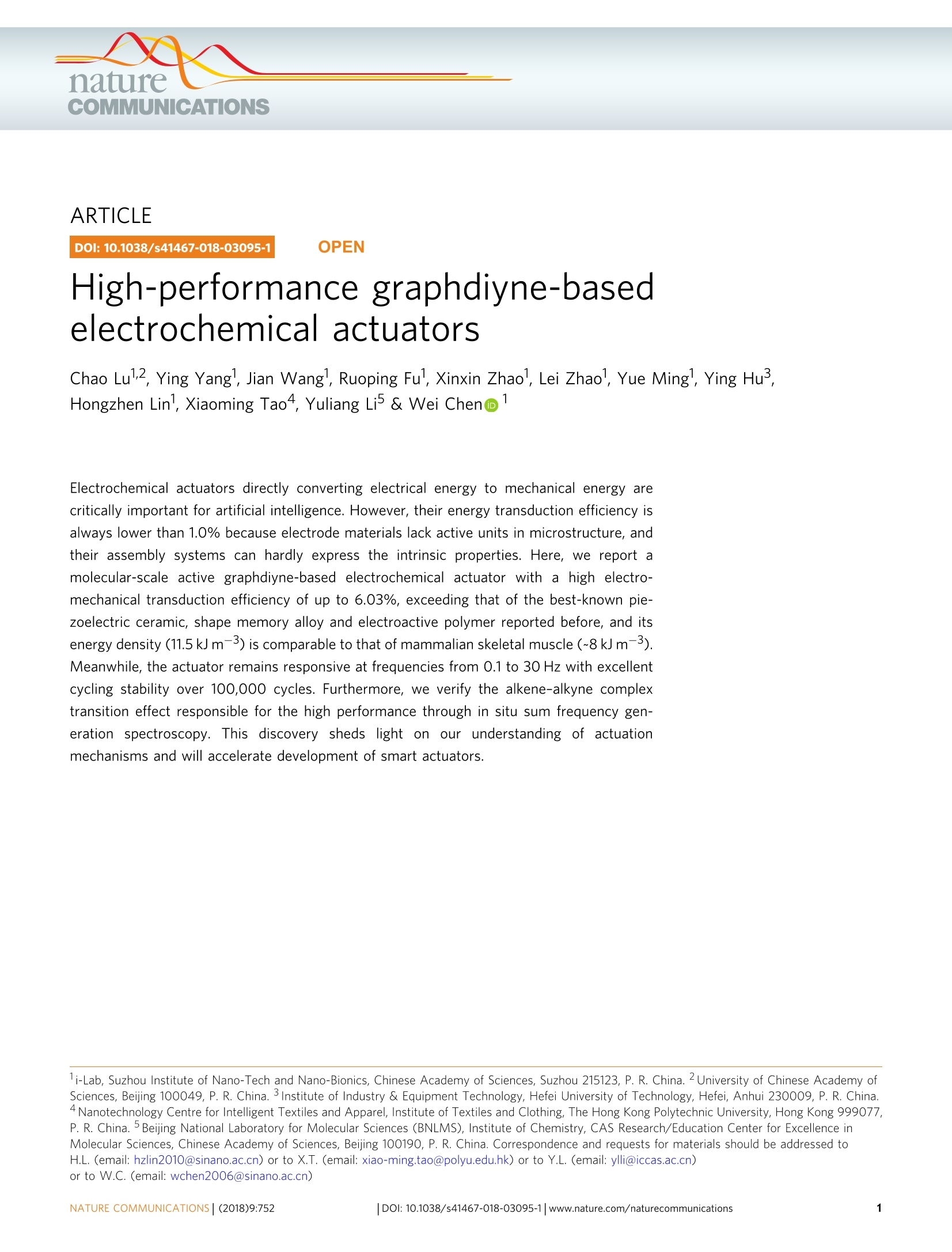
-
2/11
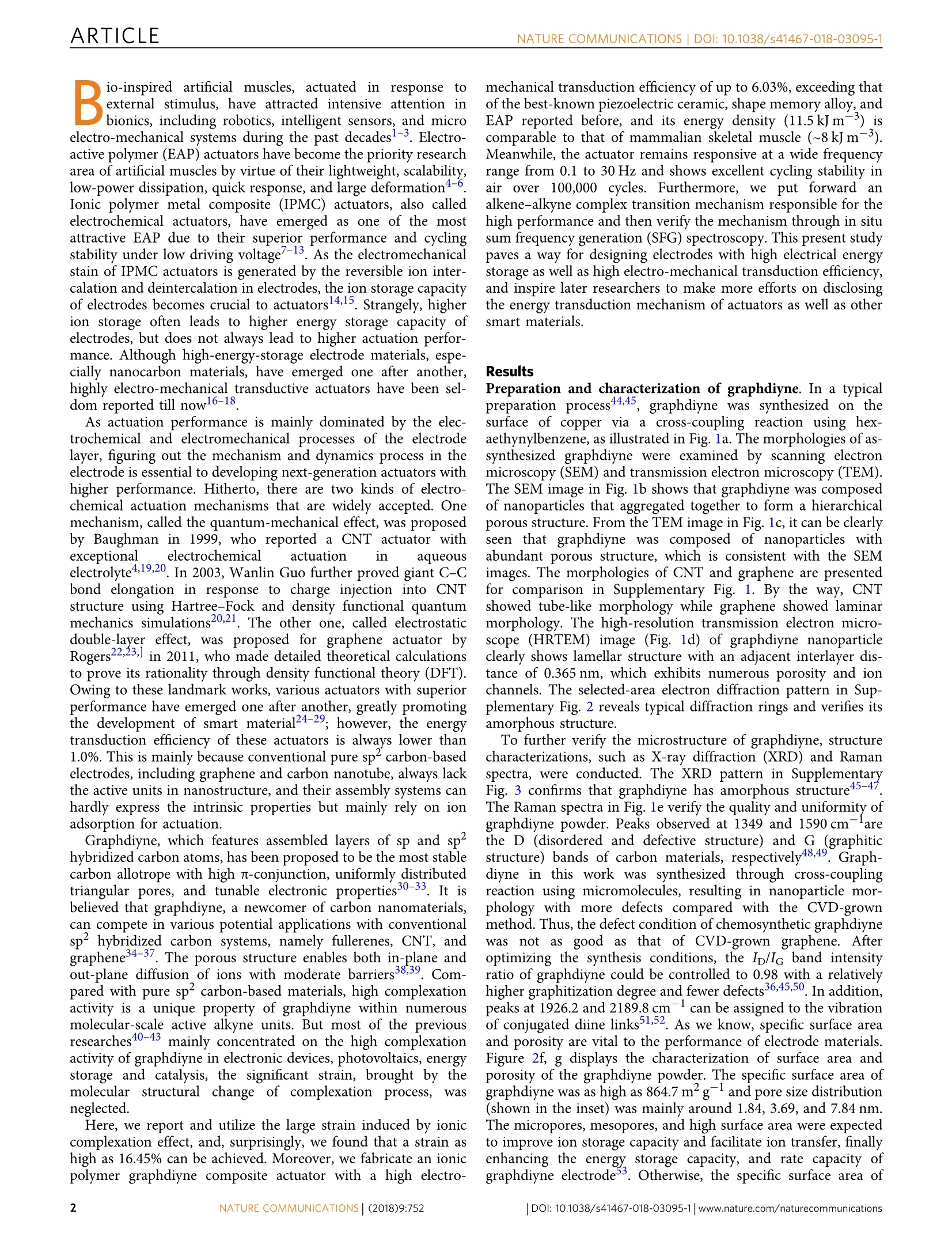
还剩9页未读,是否继续阅读?
继续免费阅读全文产品配置单
北京欧兰科技发展有限公司为您提供《石墨炔中电化学性能检测方案(其它光谱仪)》,该方案主要用于石墨烯中电化学性能检测,参考标准《暂无》,《石墨炔中电化学性能检测方案(其它光谱仪)》用到的仪器有Ekspla SFG 表面和频光谱分析系统。
我要纠错
推荐专场
其它光谱仪
更多相关方案


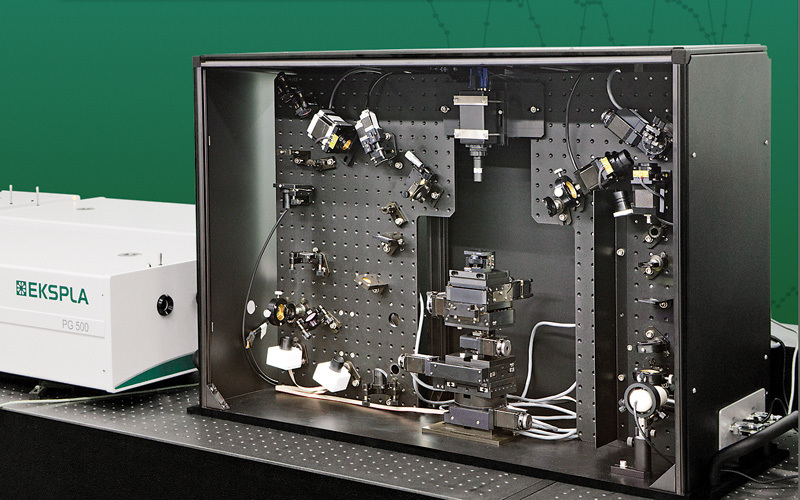
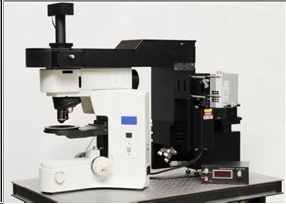
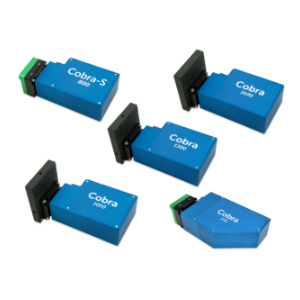
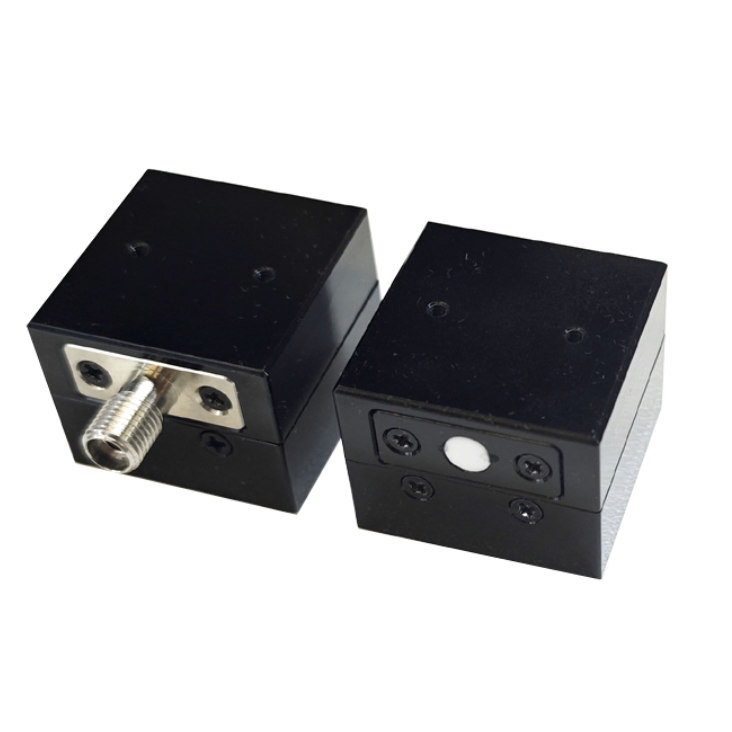
 咨询
咨询





